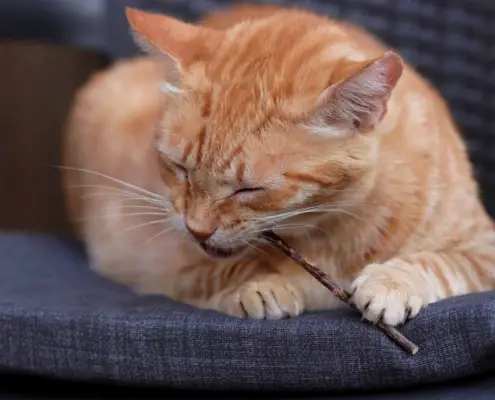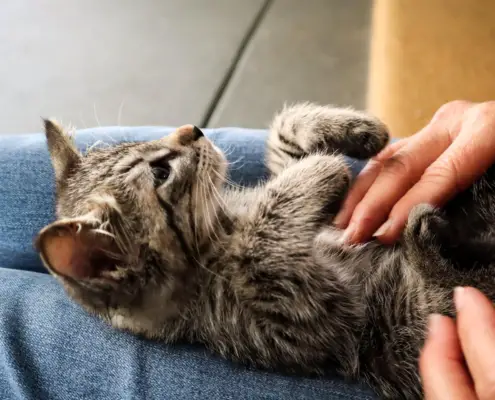
Cats are known for their exceptional hunting abilities, and this can be attributed to their innate hunting instinct. The hunting instinct in cats is deeply ingrained and has been passed down through generations of feline ancestors. This instinct is rooted in their natural predatory behavior, which enables cats to survive and thrive in the wild.
From a young age, kittens display signs of their hunting instinct. They pounce on toys, chase after moving objects, and stalk their littermates. This behavior mimics the actions of their wild counterparts, who rely on their hunting skills to secure food and defend themselves against predators.
Physical adaptations that make cats exceptional hunters
Alongside their hunting instinct, cats possess physical adaptations that contribute to their exceptional hunting abilities. One of the key adaptations is their sharp retractable claws. These claws allow cats to maintain their agility and balance while climbing trees, pouncing on prey, and engaging in other hunting behaviors.
Additionally, cats’ teeth are specifically designed for hunting. Their sharp incisors and canines help them grasp and kill their prey efficiently. Cats also have a specialized jaw structure that allows them to open their mouths wide, enabling them to deliver a swift and lethal bite.
Furthermore, cats have a flexible spine that enhances their agility and enables them to make quick and precise movements. This flexibility is crucial for successful hunting, as it allows cats to navigate through various terrains and ambush their prey effectively.
Cats’ sensory abilities for hunting
Cats possess remarkable sensory abilities that aid them in their hunting endeavors. Their keen sense of hearing allows them to detect the slightest rustle or movement, enabling them to locate hidden prey with precision. Cats can rotate their ears independently, allowing them to pinpoint the exact location of their target.
Furthermore, cats have exceptional night vision, thanks to their large pupils and a reflective layer behind their retinas called the tapetum lucidum. This adaptation enhances their ability to see in low-light conditions, making them formidable nighttime hunters. Their eyes are also uniquely positioned on the front of their heads, providing them with excellent depth perception, which is crucial for accurately judging distances when pouncing on prey.
Moreover, cats possess a highly developed sense of smell. Their olfactory receptors are more sensitive compared to humans, allowing them to detect scents that may be imperceptible to us. This keen sense of smell helps cats locate prey, even when it is hidden or camouflaged.
The role of domestication in hunting behavior
While domestication has brought about changes in many aspects of a cat’s behavior, their hunting instinct remains largely intact. Domestic cats may not rely on hunting for survival, but the instinct to hunt is still deeply ingrained within them.
The process of domestication has led to slight variations in hunting behavior among domestic cats. Some may exhibit reduced hunting prowess, while others may display heightened hunting skills. This variation can be attributed to genetic factors, individual personality traits, and environmental influences.
Hunting techniques and strategies employed by cats
Cats employ a variety of hunting techniques and strategies to secure their prey. One common technique is stalking, where a cat silently approaches its target, carefully observing its movements. Once the time is right, the cat pounces with lightning speed, catching its prey by surprise.
Another technique employed by cats is ambush hunting. Cats use their stealth and patience to hide and wait for the perfect opportunity to strike. They may camouflage themselves in the surroundings or take advantage of tall grass or foliage to remain hidden until their prey comes within striking distance.
Cats also utilize their natural agility and acrobatic skills to chase and capture prey. They are capable of impressive jumps and leaps, allowing them to catch birds in mid-air or climb trees to reach their prey.
The benefits of hunting for cats
Hunting offers numerous benefits for cats, both physically and mentally. Physically, hunting provides cats with exercise and helps them maintain their weight and muscle tone. It also stimulates their cardiovascular system and promotes overall fitness.
Mentally, hunting engages a cat’s natural instinct and provides mental stimulation. It allows them to fulfill their natural predatory behavior, which can be highly satisfying and fulfilling for them. Hunting also helps alleviate boredom and reduces stress, contributing to a cat’s overall well-being.
Common prey for cats and their hunting patterns
Cats have a wide range of potential prey, depending on their environment and habitat. In urban areas, common prey for cats includes rodents such as mice and rats, as well as birds and insects. In rural areas, cats may encounter larger prey such as rabbits or squirrels.
Cats’ hunting patterns vary depending on the type of prey they are targeting. For small rodents, cats often employ stalking techniques, gradually closing in on their prey before delivering a swift and fatal bite. When it comes to birds, cats may use their agility and quick reflexes to catch them in mid-air or climb trees to reach nests.
How cats’ hunting instincts can be observed in domestic settings
Even in domestic settings, cats’ hunting instincts can be observed. They may exhibit stalking behaviors towards toys or household objects, pouncing and batting them as if they were real prey. This play behavior is an outlet for their hunting instinct and provides mental and physical stimulation.
Cats may also display hunting behaviors towards smaller household pets or insects that enter the home. These behaviors should be monitored and managed appropriately to ensure the safety and well-being of all animals involved.
Implications for cat owners and indoor cats
Understanding and appreciating a cat’s natural hunting instincts is essential for cat owners, particularly those with indoor cats. Indoor cats may not have the opportunity to engage in natural hunting behaviors, which can lead to boredom, frustration, and behavioral issues.
To address this, cat owners can provide environmental enrichment by incorporating interactive toys, puzzle feeders, and scratching posts into their cats’ environment. These activities simulate hunting behaviors and provide mental and physical stimulation.
Additionally, creating a safe outdoor space or using leash training techniques can allow indoor cats to experience supervised outdoor exploration, which can help fulfill their hunting instincts in a controlled and safe manner.
Appreciating cats’ natural hunting abilities
Cats are exceptional hunters, with a hunting instinct and physical adaptations that have been honed through evolution. Their sensory abilities, hunting techniques, and strategies all contribute to their prowess as hunters. While domestication has brought about changes in their hunting behavior, the instinct to hunt remains deeply ingrained within them.
Understanding and appreciating cats’ natural hunting abilities is crucial for cat owners. Providing opportunities for mental and physical stimulation, as well as environmental enrichment, can help indoor cats fulfill their hunting instincts and lead happier and healthier lives.
So, the next time you observe your cat stalking a toy or displaying their hunting prowess, remember to appreciate their natural instincts and the remarkable attributes that make them exceptional hunters.
If you enjoyed my article, I would appreciate you sharing it with your network.

Sima Ndlebe
Sima writes for CatBuzz. He is interested in Cats, Health and Fitness, and Entrepreneurship.
Published: 31 October 2023




